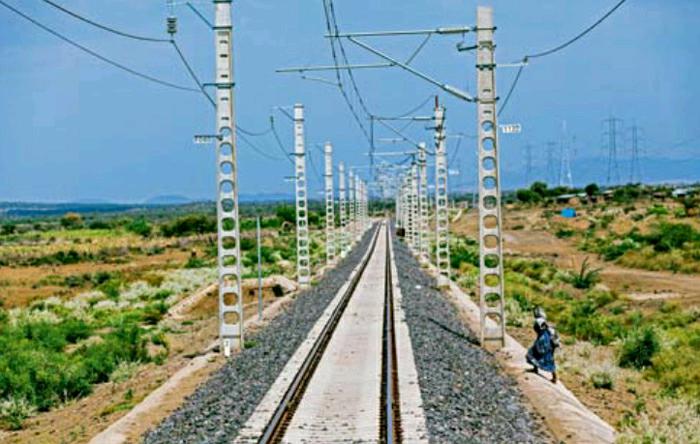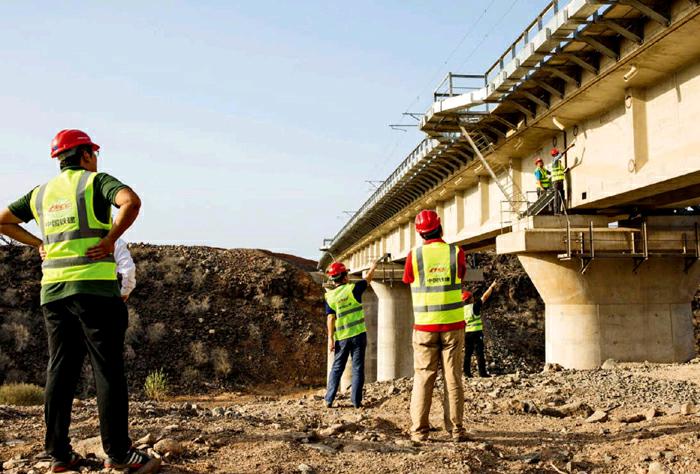Game-Changing Addis Ababa-Djibouti Railway
2017-05-20byQinBin
by+Qin+Bin

After four years of construction, an inaugural ceremony for the Addis Ababa-Djibouti Railway kicked off the rail lines operation on October 5, 2016, in the Ethiopian capital.
The Addis Ababa-Djibouti Railway links Addis Ababa, Ethiopia, to the Port of Doraleh near Djibouti City, the capital of Djibouti. The first modern electric railway on the African continent, the Addis Ababa-Djibouti Railway is also the first on the continent to adopt Chinese standards throughout the industrial chain, including technology, equipment, financing, construction and management.
The railway project marked the entrance into the overseas markets for Chinese machinery equipment and building materials valued at more than US$400 million. “Its not only a quality-of-life project tailored to African countries, but also a landmark achievement under the Belt and Road Initiative,” says Meng Fengchao, chairman of the Board of Directors of China Railway Construction Corporation Limited (CRCC)—the contractor of the Addis Ababa-Djibouti Railway. “The rail heralded China ‘going abroad with a complete industrial chain for the first time.”
The design speed of the 750-kilometer Addis Ababa-Djibouti Railway is set at 120 kilometers per hour. With a total budget of US$4 billion, the line has been called the “Tanzania-Zambia Railway of the new era.” The Tanzania-Zambia Railway was a large joint project undertaken by the governments of Tanzania, Zambia and China in the 1970s that became a symbol of China-Africa friendship. The Addis AbabaDjibouti Railway is turning a new page in African rail history, and its construction created around 48,000 local jobs. From the moment of its inception, the railway has been quietly changing local residents lives.
Local Benefits
Ethiopia and Djibouti were among the first African countries to welcome railways. However, by the late 1990s, the rails had become so worn that the speed of trains shuttling between the two countries dropped to a pathetic 15 kilometers per hour. Some dilapidated stations and stretches were abandoned.
Ethiopias lack of direct access to oceans has hindered its economic development and its peoples wellbeing. It has a strong agricultural sector, but relies heavily on imports and exports. Djibouti, occupy- ing an area of only 23,000 square kilometers, has at times struggled to produce the resources it needs for economic development. However, the country lies on the coast of the Red Sea and the Gulf of Aden, near the Suez Canal, one of the worlds busiest shipping routes. It was clear that a fast, high-capacity rail through the two countries would be a game-changer.
As early as the beginning of the 21st Century, Ethiopias Ministry of Transport signed a contract with the China Civil Engineering Construction Corporation (CCECC), a subsidiary of CRCC, looking for solutions on railway planning and construction from the engineering enterprise. In a country like Ethiopia with underdeveloped infrastructure and a meager supply of power and construction materials, building an electric railway would be a tremendous challenge. The construction plan was only approved and implemented after several drafts.
Li Wuliang, now general manager of CCECCs Ethiopia office, served as project manager during construction of the railways Mieso-Dawanle section in Ethiopia. He recalled his shock upon first arriving at Mieso: Local ethnic Somalis were herding sheep and cattle along the railway line, fully armed with automatic rifles, and very alert for strange faces.
“If we want rail construction to happen smoothly, the first thing we must do is to make friends with locals and respect their needs,” said Li at the time. He quickly sought meetings with local chiefs and elders and assigned administrators to keep him informed of local concerns.
From the initial site investigation, construction of the Addis Ababa-Djibouti Railway has merged with the local communities. When water interruptions occurred, the project department organized water trucks to serve locals around the clock. In 2015, when Ethiopia was plagued by a great drought, the project department used its construction trucks to transport disasterrelief grain donated by the international community. Thanks to the project department, in just a few years, every major village along the railway was accessible by roads and had wells. Teaching materials were donated to elementary schools, and funds were raised for governmental AIDS prevention training. The project won over the locals, who could see big benefits long before the first train passed.
A 27-year-old Ethiopian employee of CCECC served as a team leader on the railways Dire Dawa section. Before joining the company, he worked for the local office of an Indian enterprise as a steel bender for seven months. He came to CCECC to learn bridge construction, which not only enhanced his professional skills, but also doubled his salary. Shortly after joining CCECC, his child was born, and the gifts and congratulations from his new co-workers greatly moved him. He has now been working for the company for three years.
A 28-year-old Ethiopian woman worked for CCECC in a senior role. Having studied Chinese language and economics at Beijing-based Capital University of Economics and Business, she joined CCECC in 2013 as an interpreter. At that time, her monthly income already dwarfed that of most of her Ethiopian friends. When the railway was completed, she launched her own car rental business by purchasing six pickup trucks to provide to Chinese enterprises operating in Ethiopia. She also plans to import clothes and tires from China and sell them in Addis Ababa.
Development Opportunities
Using railway construction as a platform, Chinese enterprises have expanded their industrial chain to fields including ports, logistics and real estate. Goods are piled up along the road outside the storage yard of the Djibouti port. Trucks waiting to load or unload queue up for miles. Local businessmen are optimistic about the future. When the Addis Ababa-Djibouti Railway opened, the transport time for cargo from Djibouti to Addis Ababa dropped from a week to about 10 hours, greatly enhancing cross-border logistics efficiency.
Near the old Djibouti port, a large multi-functional wharf is under construction. Its completion will double capacity and increase the volume of goods coming to and from Ethiopia significantly. The Addis Ababa-Djibouti Railway alone is expected to add another two percent to Ethiopias economic growth rate. In this sense, it is literally a road to prosperity.
The Addis Ababa-Djibouti Railways completion has enabled the Ethiopian government to see a path to industrialization and towards becoming one of Africas manufacturing hubs. Its operation has already boosted international investorsconfidence in potential industrial projects in Ethiopia. According to Lu Haiqiang, vice general manager of CCECCs Ethiopia office, Dire Dawa used to lack modern enterprises. However, since construction of the railway began in 2012, investors from Ethiopia, as well as other countries such as India and Turkey, quickly spotted the enormous business opportunities. A flurry of projects has been launched, including cement plants, automobile plants, and textile mills.
At the invitations of local governments, Chinese enterprises that had been working on the Addis Ababa-Djibouti Railway broke ground on other projects such as industrial parks and property development, highlighting new operational modes for Chinese rail producers going abroad. “The Addis Ababa-Djibouti Railway marks Ethiopias arrival to industrialized society,” says Zheng Jun, a manager with CCECCs Ethiopian office. “Djibouti will become a regional logistics center. Understanding the many opportunities that will emerge, Chinese enterprises will use railway construction as a platform to continue expanding industrial chains and exploring regional markets more deeply. If a railway is a thread, its pearls are ports, real estate, logistics, and tourism. In the future, railways will string together more stories of mutual benefits and win-win cooperation, and even more countries including Somalia, South Sudan and Eritrea will benefit from railways.”